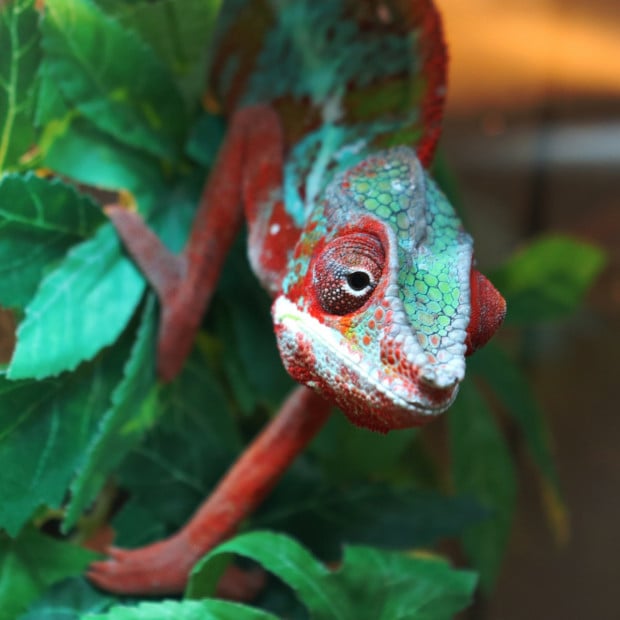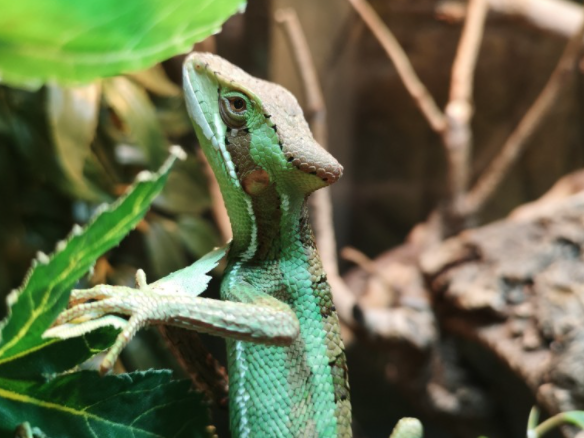-
Categories: Care sheetsLizards
Casque head iguana, Laemanctus serratus, care sheet
Casque head iguana, Laemanctus serratus, husbandry guide from the experts at Swell Reptiles, covering housing, heating, lighting and more.
- Casque head iguanas are a unique and interesting pet
- A great choice for intermediate keepers looking for a challenge
- Opportunity to create a stunning large display enclosure
Do Casque head iguanas make good pets?
Casque head iguanas, otherwise known as Cone head iguanas or basilisks are unique looking arboreal lizards with a large crown on their head and an extremely long tail, almost three times the length of their relatively short bodies. This species is quite skittish and moves fast, but they can be tamed down with enough time and effort and will usually tolerate handling eventually.
Casque head iguanas are indigenous to the tropical rainforests of Central America, however, all of the Casque head iguanas for sale at Swell Reptiles were captive bred in the UK, meaning you can rest assured that your new iguana came from a reliable source with minimal impact on the environment.
What size enclosure is required for a Casque head iguana?
Due to their arboreal and highly active nature, Casque head iguanas require a good sized enclosure that provides them with plenty of vertical space. This species also has high humidity requirements, which means wooden vivariums are not the best option as they are likely to warp over time in consistent moisture.
We recommend a minimum enclosure size for this species of 90 x 45 x 90cm (36 x 18 x 36”), so the Exo Terra Paludarium 90x45x90cm is a great option for a single adult. We recommend against keeping more than one individual together, as competition is likely to occur which can lead to stress and related health issues in the outcompeted individual.
What temperature do Casque head iguanas need to be kept at?
Just like any reptile, Casque head iguanas are ectotherms and rely on external heat sources to control their body temperature. They do best with a basking temperature between 30-32°C (89-98°F) and a cool end temperature sitting closer to 22-25°C (71-77°F), which should be achieved using an overhead heating system to create a thermogradient that runs from the top to the bottom of the enclosure.
All heating equipment must be connected to a thermostat to ensure their safety, and the required thermostat depends on the chosen heating element. If you choose to use a basking lamp, you will need a dimming thermostat, whereas if you choose a ceramic heat emitter, then you will require a pulse thermostat.
Should I provide UVB for my Casque head iguana?
Casque head iguanas are diurnal animals, meaning they are awake and active during the day. Therefore, they would regularly be exposed to sunlight in nature and should be provided with UVB giving them a UVI between 3-4 in captivity to ensure they remain happy and healthy and prevent diseases such as metabolic bone disease which can have catastrophic results.
The percentage of UV that is required will depend on the height of the light fixture from your Casque head iguanas highest basking point. To achieve the required UVI, you can either use an Arcadia ProT5 Kit - Forest 6% positioned 30-40cm (12-15”) from the highest basking point, or an Arcadia ProT5 Kit - Desert 12% positioned 40-60cm (16-24”) from the highest basking point.
What substrate should a Casque head iguana have?
Due to their high humidity requirements, a moisture-retaining substrate should be used to help keep the humidity levels up. This can be something simple such as coco soil, or a more complex planting substrate such as Arcadia EarthMix or ProRep Bio Life Forest which are far better for plant growth.
If you do decide to go down the bioactive route, a drainage layer of Hydro Rocks topped with a sheet of Hydro Matting is an important consideration. Not only will this protect the roots of your plant by preventing the soil from becoming waterlogged, but it will also provide a water reservoir from which water can be absorbed back into the substrate if it begins to dry out.
How can I maintain the humidity for my Casque head iguana?
Casque head iguanas require humidity levels between 70-90% which is quite high and will require special attention to maintain. Traditionally, high humidity is maintained using a handheld spray bottle and misting the enclosure down a few times a day (depending on how quickly the humidity drops). Automated fogging or rain systems are also good options, particularly if you will be away from home all day at work for example. The addition of a water dish, live plants and reptile moss will also help to keep the humidity levels up.
How do I decorate a Casque head iguana’s vivarium?
Being arboreal reptiles, Casque head iguanas should be provided with plenty of branches and vines to allow them to utilise all of the vertical space in their enclosure. Foliage can then be added to provide covered safe spaces, either using live or artificial plants placed around the enclosure, both in the substrate layer and pinned to the background (or stuck to the glass for artificial plants).
What do Casque head iguanas eat?
Casque head iguanas are insectivores so should be fed a varied diet of livefoods such as crickets, locusts, cockroaches and calci worms. Other feeder options can be provided occasionally such as wax worms or beetle grubs, but these are high in fat and should be kept for occasional feedings/treats only.
All livefood offered to a Casque head iguana should be supplemented according to a feeding cycle to ensure they get all of the nutrients they require to remain healthy. At Swell Reptiles we recommend using a calcium-rich multivitamin on every feed, such as Arcadia EarthPro-A, a calcium plus magnesium supplement on every fourth feed, such as Arcadia CalciumPro Mg and finally, a vitamin D3 supplement on every eighth feed such as Arcadia EarthPro RevitaliseD3.
How do I buy a Casque head iguana?
If you would like to purchase one of our UK captive bred Casque head iguanas, you will need to collect this from our store as we do not ship livestock online. If this is not a problem for you, please come in and see us.
To ensure all of our livestock goes to good homes, we will ask you a few quick questions and also ask to see some images of a suitable set-up ready for the animal to go into. We reserve the right to refuse adoption to anyone we feel is unprepared to adopt.
For more detailed husbandry information, please refer to our dedicated Casque Head Iguana Care Sheet. You can also check out alternatives to the Casque Head Iguana, such as the Yemen chameleon or Chinese water dragon.
| Common names | Casque head iguana, Cone head iguana, Cone head basilisk |
| Scientific name | Laemanctus serratus |
| Country | Central America |
| Captive-bred | Yes |
| Adult size | 25cm (10") |
| Natural habitat | Rainforest habitats |
| Housing | 90 x 45 x 90cm (36 x 18 x 36”) |
| Ideal temperature | 30-32°C (89-98°F) (warm end); 22-25°C (71-77°F) (cool end) |
| UVI | 3-4 |
| Ideal humidity | 70-90% |
| Diet | Insectivorous |
| Average lifespan | 5-7 years |
| Personality | Stubborn, but can be tamed |
| Ease of handling | Moderate |
| Cohabitable | No |
-
 Chinese water dragon, Physignathus cocincinusFrom £70.00Out of stock
Chinese water dragon, Physignathus cocincinusFrom £70.00Out of stock -
 Yemen chameleon, Chamaeleo calyptratusFrom £125.00 Regular Price £150.00 Save £25.00Out of stock
Yemen chameleon, Chamaeleo calyptratusFrom £125.00 Regular Price £150.00 Save £25.00Out of stock -
 Jackson's chameleon, Trioceros jacksoniiFrom £60.00Out of stock
Jackson's chameleon, Trioceros jacksoniiFrom £60.00Out of stock -
 Panther chameleon, Furcifer pardalisFrom £375.00In stock
Panther chameleon, Furcifer pardalisFrom £375.00In stock









